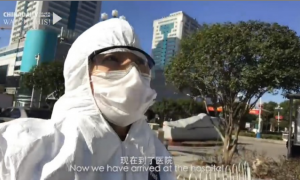Researchers at Shanghai Jiaotong University have wrapped up a five-year study in which they used unmanned aerial vehicles to monitor air pollutants in the Yangtze River Delta region. They say temperature inversion - an increase in temperature with height - is one of the factors leading to smog.
Researchers at Shanghai Jiaotong University's School of Naval Architecture, Ocean and Civil Engineering have created two versions of the aircraft - a helicopter and a small plane. When flying one kilometer above the ground, they can monitor an area of 16 square kilometers. Information recorded by the sensors onboard is then turned into 3-dimensional graphs, with different colors showing the levels of pollutants at different altitudes.
Peng says from the ground to one kilometer high. the level of PM2.5 particles decreases with height. But when a temperature inversion layer forms, it hinders the particles from being diffused. A temperature inversion means that the normal decrease in temperature with height switches and the temperature increases with height.
"An inversion acts like a lid, trapping pollutants below it and allowing them to build up. If the sky is very hazy, or if sunsets are very red, there is likely an inversion somewhere in the lower atmosphere. this explains how even with a similar amount of pollutants, smog doesn't necessarily form," said Prof. Peng Zhongren, Shanghai Jiaotong University.
But researchers say they still need more solid figures to see how temperature inversion contributes to smog. The team is already working with the Shanghai Environment Monitoring Center for further research as officials say using unmanned aerial vehicles to monitor air quality compliments current methods. In the past, the city's air quality monitoring stations were all ground-based. In 2013, researchers started using a balloon to monitor air pollution, but it lacks flexibility.
"The balloon monitors the air quality from the ground to around 1,000 meters up, but they cannot move vertically. With these aircraft, we're able to zip around more and learn about the diffusion process of the pollutants wherever we want," said Liu Qingchang, researcher of Shanghai Jiaotong Unversity.
Each drone costs around 500 thousand yuan. Jiaotong University says it's developing cheaper models so that more drones can be used to monitor air pollution. Experts say with more precise information they expect to help the city produce more accurate air pollution forecasts.







